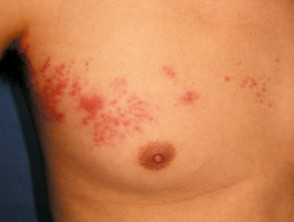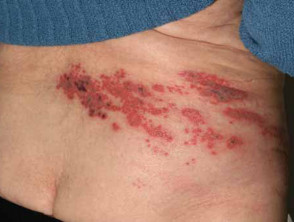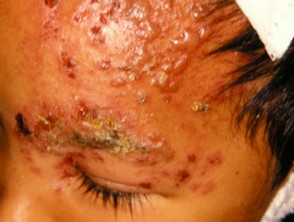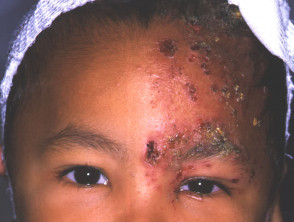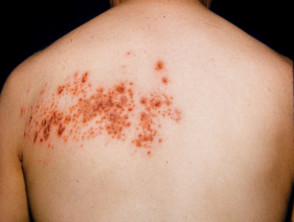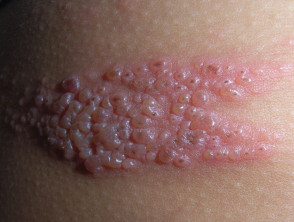What is herpes zoster?
Herpes zoster is a localised, blistering and painful rash caused by reactivation of varicella-zoster virus (VZV). Herpes zoster is also called shingles.
VZV is also called herpesvirus 3 and is a member of the Herpesvirales order of double-stranded DNA viruses.
Herpes zoster
Who gets herpes zoster?
Anyone who has had varicella (chickenpox) may subsequently develop herpes zoster. Zoster can occur in childhood but is much more common in adults, especially older people. People with various kinds of cancer have a 40% increased risk of developing zoster. People who have had zoster rarely get it again; the chance of getting a second episode is about 1%.
Herpes zoster often affects people with weak immunity.
What causes herpes zoster?
After primary infection—varicella—VZV remains dormant in dorsal root ganglia nerve cells in the spine for years before it is reactivated and migrates down sensory nerves to the skin to cause herpes zoster.
It is not clear why herpes zoster affects a particular nerve fibre. Triggering factors are sometimes recognised, such as:
- Pressure on the nerve roots
- Radiotherapy at the level of the affected nerve root
- Spinal surgery
- An infection
- An injury (not necessarily to the spine)
- Contact with someone with varicella or herpes zoster
What are the clinical features of herpes zoster?
Herpes zoster is characterised by dermatomal distribution, that is the blisters are confined to the cutaneous distribution of one or two adjacent sensory nerves. This is usually unilateral, with a sharp cut-off at the anterior and posterior midlines.
The clinical presentation of herpes zoster depends on the age and health of the patient and which dermatome is affected.
The first sign of herpes zoster is usually localised pain without tenderness or any visible skin change. It may be severe, relating to one or more sensory nerves. The pain may be just in one spot, or it may spread out. The patient may feel quite unwell with fever and headache. The lymph nodes draining the affected area are often enlarged and tender.
Within one to three days of the onset of pain, a blistering rash appears in the painful area of skin. It starts as a crop of red papules. New lesions continue to erupt for several days within the distribution of the affected nerve, each blistering or becoming pustular then crusting over.
The chest (thoracic), neck (cervical), forehead (ophthalmic) and lumbar/sacral sensory nerve supply regions are most commonly affected at all ages. The frequency of ophthalmic herpes zoster increases with age. Herpes zoster occasionally causes blisters inside the mouth or ears, and can also affect the genital area. Sometimes there is pain without rash—herpes zoster "sine eruptione"—or rash without pain, most often in children.
Pain and general symptoms subside gradually as the eruption disappears. In uncomplicated cases, recovery is complete within 2–3 weeks in children and young adults, and within 3–4 weeks in older patients.
Herpes zoster
See more images of herpes zoster.
What are the complications of herpes zoster?
- Involvement of several dermatomes, or sometimes, bilateral eruptions in unique dermatomes
- Eye complications when the ophthalmic division of the fifth cranial nerve is involved
- Deep blisters that take weeks to heal followed by scarring
- Muscle weakness in about one in 20 patients. Facial nerve palsy is the most common result (see Ramsay Hunt syndrome). There is a 50% chance of complete recovery, but some improvement can be expected in nearly all cases
- Infection of internal organs, including the gastrointestinal tract, lungs, and brain (encephalitis)
Herpes zoster is infectious to people who have not previously had chickenpox.
Herpes zoster in the early months of pregnancy can harm the fetus, but luckily this is rare. Shingles in late pregnancy can cause chickenpox in the fetus or newborn. Herpes zoster may then develop as an infant.
Post-herpetic neuralgia
Post-herpetic neuralgia is defined as persistence or recurrence of pain in the same area, more than a month after the onset of herpes zoster. It becomes increasingly common with age, affecting about a third of patients over 40. It is particularly likely if there is facial infection. Post-herpetic neuralgia may be a continuous burning sensation with increased sensitivity in the affected areas or spasmodic shooting pain. The overlying skin is often numb or exquisitely sensitive to touch. Sometimes, instead of pain, the neuralgia results in a persistent itch (neuropathic pruritus).
What is the treatment of herpes zoster?
Prevention of herpes zoster
Because the risk of serious complications from herpes zoster is more likely in older people, those aged over 60 years might consider the zoster vaccine, which can reduce the incidence of herpes zoster by half. In people who do get herpes zoster despite being vaccinated, the symptoms are usually less severe, and post-herpetic neuralgia is less likely to develop. In New Zealand, the zoster vaccine will be funded from 1 April 2018 for people aged between 66 and 80 years old.
Herpes zoster vaccination is contraindicated in immunosuppressed patients due to the risk of it causing disseminated herpes zoster infection.
General measures
- Rest and pain relief
- Protective ointment applied to the rash, such as petroleum jelly.
- Oral antibiotics for secondary infection
Specific measures
Antiviral treatment can reduce pain and the duration of symptoms if started within one to three days after the onset of herpes zoster. Aciclovir 800 mg 5 times daily for seven days is most often prescribed. Valaciclovir and famciclovir are also useful. The efficacy of prescribing systemic steroids is unproven.
Post-herpetic neuralgia
- Early use of antiviral medication
- Local anaesthetic applications
- Topical capsaicin
- Tricyclic antidepressant medications such as amitriptyline
- Anti-epileptic medications gabapentin and pregabalin
- Transcutaneous electrical nerve stimulation or acupuncture
- Botulinum toxin into the affected area
Nonsteroidal anti-inflammatories and opioids are generally unhelpful.
